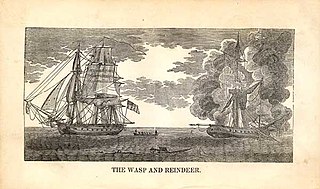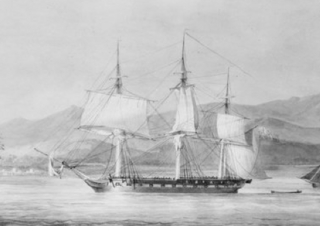
HMS Pomone was a 38-gun Leda-class fifth rate of the Royal Navy launched in 1805. She saw action during the Napoleonic Wars, primarily in the Mediterranean while under the command of Captain Robert Barrie. She was wrecked off The Needles, part of the Isle of Wight, in 1811. The wreck is a Protected Wreck managed by Historic England.

HMS Reindeer was a Royal Navy 18-gun Cruizer-class brig-sloop of the Royal Navy, built by Samuel & Daniel Brent at Rotherhithe and was launched in 1804. She was built of fir, which made for more rapid construction at the expense of durability. Reindeer fought in the Napoleonic Wars before succumbing in 1814 to the guns of USS Wasp during the War of 1812.
HMS Druid was a 32-gun Hermione-class fifth-rate frigate of the British Royal Navy, launched in 1783 at Bristol. She served in the French Revolutionary Wars and the Napoleonic Wars, capturing numerous small prizes. One of her commanders, Captain Philip Broke, described Druid as a "point of honour ship", i.e., a ship too large to run but too small to fight. He and his biographer's view was that it was a disgrace to use a ship like her as a warship. She was broken up in 1813, after a thirty-year career.
HMS Bold was a 14-gun Archer-class gun-brig of the Royal Navy built at Blackwall Yard. She took part in several minor actions and captured some prizes before she grounded in 1811 and was broken up shortly thereafter.

HMS Persian was a Cruizer-class brig-sloop built by Daniel List and launched at Cowes in 1809. She captured two privateers before she wrecked in 1813.
HMS Nemesis was a 28-gun Enterprise-class sixth-rate frigate of the Royal Navy. The French captured her in 1795 at Smyrna, but in 1796 a squadron led by Barfleur brought her out of the neutral port of Tunis. Throughout her career she served under a number of commanders who would go on to have distinguished careers. She was converted to a troopship in 1812 and was sold in 1814.
HMS Comus was a 22-gun Laurel-class sixth-rate post ship of the Royal Navy. She was launched in 1806. In 1807 she took part in one notable single-ship action and was at the capture of Copenhagen. In 1815 she spent six months with the West Africa Squadron suppressing the slave trade during which time she captured ten slavers and freed 500-1,000 slaves. She was wrecked in 1816 with no loss of life.
HMS Linnet was originally His Majesty’s revenue cutter Speedwell, launched in 1797, that the Royal Navy purchased in 1806. Linnet captured a number of privateers before the French frigate Gloire captured her in 1813. The French sold or transferred her to the Americans, who operated her as the privateer Bunkers Hill. In March 1814 the British recaptured her, but did not return her to service.
HMS Harrier was a Cruizer-class brig-sloop launched in 1804. She took part in several notable actions before she was lost in March 1809, presumed foundered.
The French brig Phaeton was a Palinure-class brig launched in 1804. The British captured her in 1806 and renamed her HMS Mignonne. In 1807 they renamed her HMS Musette. She was sold in 1814.
HMS Alphea was built of Bermudan pencil cedar as a cutter and launched in 1804. Later she was converted to a schooner. She captured a number of small prizes before September 1813 when she blew up in a single-ship action with the loss of her entire crew.

HMS Orestes was a 16-gun brig-sloop of the Seagull class of the British Royal Navy, launched in October 1805. She served during the Napoleonic Wars, primarily in the North Sea and the Channel, where she captured three privateers. The Navy sold her in 1817.
HMS Milbrook was one of six vessels built to an experimental design by Sir Samuel Bentham. After the Royal Navy took her into service in her decade-long career she took part in one notable single-ship action and captured several privateers and other vessels, all off the coast of Spain and Portugal. She was wrecked off the coast of Portugal in 1808.
HMS Pert was the French privateer Bonaparte, a ship built in the United States that HMS Cyane captured in November 1804. The Royal Navy took Bonaparte into service as HMS Pert. Pert was wrecked off the coast of what is now Venezuela in October 1807.
During the period of the Napoleonic Wars, the British Royal Navy twice employed a vessel named His Majesty's hired armed cutter Albion, though these are probably the same vessel:
HMS Earnest was launched at Leith in 1805 as one of 48 later Archer-class gun brigs for the British Royal Navy. During her naval career Earnest captured five small privateers and numerous merchant vessels. In 1816 the Admiralty sold her and she became the merchantman Earnest. She continued to sail and was last listed in 1850.

HMS Monkey was launched in 1801 at Rochester. She served in the Channel, North Sea, and the Baltic, and was wrecked in December 1810.
HMS Growler was a Archer-class gun-brig built for the British Royal Navy and launched in 1804. She captured several French privateers and one Danish privateer, and took part in two actions that earned her crew the Naval General Service Medal (NGSM). She was sold in 1815.

HMS Minerva was a 32-gun fifth-rate Thames-class frigate of the Royal Navy, launched in 1805 at Deptford. Her namesake was the Roman goddess Minerva.
HMS Conflict was launched in 1805. She captured a number of vessels, including privateers, and participated in several major actions. She disappeared in November 1810 with the loss of all her crew.






